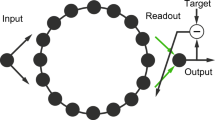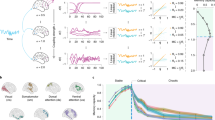Abstract
A large body of experimental and theoretical work on neural coding suggests that the information stored in brain circuits is represented by time-varying patterns of neural activity. Reservoir computing, where the activity of a recurrently connected pool of neurons is read by one or more units that provide an output response, successfully exploits this type of neural activity. However, the question of system robustness to small structural perturbations, such as failing neurons and synapses, has been largely overlooked. This contrasts with well-studied dynamical perturbations that lead to divergent network activity in the presence of chaos, as is the case for many reservoir networks. Here, we distinguish between two types of structural network perturbations, namely local (e.g., individual synaptic or neuronal failure) and global (e.g., network-wide fluctuations). Surprisingly, we show that while global perturbations have a limited impact on the ability of reservoir models to perform various tasks, local perturbations can produce drastic effects. To address this limitation, we introduce a new architecture where the reservoir is driven by a layer of oscillators that generate stable and repeatable trajectories. This model outperforms previous implementations while being resistant to relatively large local and global perturbations. This finding has implications for the design of reservoir models that capture the capacity of brain circuits to perform cognitively and behaviorally relevant tasks while remaining robust to various forms of perturbations. Further, our work proposes a novel role for neuronal oscillations found in cortical circuits, where they may serve as a collection of inputs from which a network can robustly generate complex dynamics and implement rich computations.








Similar content being viewed by others
References
Akam, T., Oren, I., Mantoan, L., Ferenczi, E., & Kullmann, D. M. (2012). Oscillatory dynamics in the hippocampus support dentate gyrus-CA3 coupling. Nature Neuroscience, 15(5), 763–768.
Arieli, A., Sterkin, A., Grinvald, A., & Aertsen, A. (1996). Dynamics of ongoing activity: explanation of the large variability in evoked cortical responses. Science, 273(5283), 1868–1871.
Bai, Z. (1997). Circular law. The Annals of Probability, 25(1), 494–529.
Banerjee, A., Seriv̀s, P., & Pouget, A. (2008). Dynamical constraints on using precise spike timing to compute in recurrent cortical networks. Neural Computation, 20(4), 974–993.
Barak, O., Sussillo, D., Romo, R., Tsodyks, M., & Abbott, L. F. (2013). From fixed points to chaos: Three models of delayed discrimination. Progress in Neurobiology 103, 10.1016/j.pneurobio.2013.02.002.
Bernacchia, A., Seo, H., Lee, D., & Wang, X. J. (2011). A reservoir of time constants for memory traces in cortical neurons. Natural Neuroscience, 14(3), 366–372. doi:10.1038/nn.2752.
Bertschinger, N., & Natschläger, T. (2004). Real-time computation at the edge of chaos in recurrent neural networks. Neural Computation, 16(7), 1413–1436.
Bonifazi, P., Goldin, M., Picardo, M. A., Jorquera, I., Cattani, A., Bianconi, G., Represa, A., Ben-Ari, Y., & Cossart, R. (2009). GABAergic hub neurons orchestrate synchrony in developing hippocampal networks. Science, 326(5958), 1419–1424.
Brin, M., & Stuck, G. (2002). Introduction to dynamical systems: Cambridge University Press.
Buhusi, C.V., & Meck, W.H. (2005). What makes us tick? Functional and neural mechanisms of interval timing. Nature Reviews Neuroscience, 6(10), 755–765. doi:10.1038/nrn1764.
Buonomano, D. V., & Maass, W. (2009). State-dependent computations: spatiotemporal processing in cortical networks. Nature Reviews Neuroscience, 10(2), 113–125.
Buxhoeveden, D. P., & Casanova, M. F. (2002). The minicolumn hypothesis in neuroscience. Brain, 125(5), 935–951.
Churchland, M. M., & Shenoy, K. V. (2007). Temporal complexity and heterogeneity of single-neuron activity in premotor and motor cortex. Journal of neurophysiology, 97(6), 4235–4257.
Churchland, M. M., Cunningham, J. P., Kaufman, M. T., Foster, J. D., Nuyujukian, P., Ryu, S. I., & Shenoy, K. V. (2012). Neural population dynamics during reaching. Nature, 487(7405), 51–56. doi:10.1038/nature11129.
De Zeeuw, C. I., Hoebeek, F. E., Bosman, L. W., Schonewille, M., Witter, L., & Koekkoek, S. K. (2011). Spatiotemporal firing patterns in the cerebellum. Nature Reviews Neuroscience, 12(6), 327–344.
Enel, P. (2014). Dynamic representation in the prefrontal cortex : insights from comparing reservoir computing and primate neurophysiology: Theses, Université Claude Bernard - Lyon I.
Ermentrout, B. (1996). Type I membranes, phase resetting curves, and synchrony. Neural computation, 8(5), 979–1001.
Farries, M. A., & Wilson, C. J. (2012). Phase response curves of subthalamic neurons measured with synaptic input and current injection. Journal of Neurophysiology, 108(7), 1822–1837. doi:10.1152/jn.00053.2012.
Fiete, I. R., Burak, Y., & Brookings, T. (2008). What grid cells convey about rat location. The Journal of Neuroscience, 28(27), 6858–6871.
Froemke, R. C., & Schreiner, C. E. (2015). Synaptic plasticity as a cortical coding scheme. Current opinion in neurobiology, 35, 185–199.
Fu, Y., Yu, Y., Paxinos, G., Watson, C., & Rusznák, Z. (2015). Aging-dependent changes in the cellular composition of the mouse brain and spinal cord. Neuroscience, 290(0), 406–420. doi:10.1016/j.neuroscience.2015.01.039.
Goel, A., & Buonomano, D. V. (2014). Timing as an intrinsic property of neural networks: evidence from in vivo and in vitro experiments. Philosophical Transactions of the Royal Society B: Biological Sciences, 369(1637), 20120,460.
Häusler, S., Markram, H., & Maass, W. (2003). Perspectives of the high-dimensional dynamics of neural microcircuits from the point of view of low-dimensional readouts. Complexity, 8(4), 39– 50.
Haykin, S. (2002). Adaptive filter theory. Prentice Hall, 2, 478–481.
Hoerzer, G. M., Legenstein, R., & Maass, W. (2014). Emergence of complex computational structures from chaotic neural networks through reward-modulated Hebbian learning. Cerebral cortex, 24(3), 677–690.
Hooper, S. L. (2001). Central Pattern Generators. In eLS: Wiley.
Jaeger, H. (2002). Adaptive nonlinear system identification with echo state networks. pp 593–600.
Jarvis, S., Rotter, S., & Egert, U. (2010). Extending stability through hierarchical clusters in echo state networks. Frontiers in Neuroinformatics, 4.
Joshi, P., & Maass, W. (2005). Movement generation with circuits of spiking neurons. Neural Computation, 17(8), 1715–1738.
Kahana, M. J. (2006). The cognitive correlates of human brain oscillations. The Journal of Neuroscience, 26 (6), 1669–1672.
Keller, C. J., Honey, C. J., Mégevand, P, Entz, L., Ulbert, I., & Mehta, A. D. (2014). Mapping human brain networks with cortico-cortical evoked potentials. Philosophical Transactions of the Royal Society B: Biological Sciences, 369(1653), 20130, 528.
Laje, R., & Buonomano, D. V. (2013). Robust timing and motor patterns by taming chaos in recurrent neural networks. Natural Neuroscience, 16. doi:10.1038/nn.3405.
Lajoie, G., Lin, K. K., & Shea-Brown, E. (2013). Chaos and reliability in balanced spiking networks with temporal drive. Physical Review E, 87(5), 052,901.
Lajoie, G., Thivierge, J. P., & Shea-Brown, E. (2014). Structured chaos shapes spike-response noise entropy in balanced neural networks. Frontiers in Computational Neuroscience, 8. doi:10.3389/fncom.2014.00123.
Li, X., Zhong, L., Xue, F., & Zhang, A. (2015). A Priori Data-Driven Multi-Clustered Reservoir Generation Algorithm for Echo State Network. PloS One, 10(4).
London, M., Roth, A., Beeren, L., Häusser, M., & Latham, P. E. (2010). Sensitivity to perturbations in vivo implies high noise and suggests rate coding in cortex. Nature, 466(7302), 123–127.
Lustig, C., Matell, M. S., & Meck, W. H. (2003). Not “just” a coincidence: Frontal-striatal interactions in working memory and interval timing. Memory, 13(3-4), 441–448.
Maass, W., Natschläger, T., & Markram, H. (2002). Real-time computing without stable states: A new framework for neural computation based on perturbations. Neural Computation, 14(11), 2531–2560.
MacKay, W. A. (2005). Wheels of motion: oscillatory potentials in the motor cortex. Motor Cortex in Voluntary Movements: A Distributed System for Distributed Functions, 181–211.
Mainen, Z. F., & Sejnowski, T. J. (1995). Reliability of spike timing in neocortical neurons. Science, 268 (5216), 1503–1506.
Mante, V., Sussillo, D., Shenoy, K. V., & Newsome, W. T. (2013). Context-dependent computation by recurrent dynamics in prefrontal cortex. Nature, 503(7474), 78–84.
Mauk, M. D., & Buonomano, D. V. (2004). The neural basis of temporal processing. Annual Review Neuroscience, 27, 307–340.
Mazurek, M. E., Roitman, J. D., Ditterich, J., & Shadlen, M. N. (2003). A role for neural integrators in perceptual decision making. Cerebral cortex, 13(11), 1257–1269.
Meunier, D., Lambiotte, R., & Bullmore, E. T. (2010). Modular and hierarchically modular organization of brain networks. Frontiers in neuroscience, 4.
Miall, C. (1989). The storage of time intervals using oscillating neurons. Neural Computation, 1(3), 359–371.
Molgedey, L., Schuchhardt, J., & Schuster, H. G. (1992). Suppressing chaos in neural networks by noise. Physical Review Letters, 69(26), 3717–3719.
Mountcastle, V. B. (1997). The columnar organization of the neocortex. Brain, 120(4), 701–722.
Pakkenberg, B., Pelvig, D., Marner, L., Bundgaard, M. J., Gundersen, H. J. G., Nyengaard, J. R., & Regeur, L. (2003). Aging and the human neocortex. Proceedings of the 6th International Symposium on the Neurobiology and Neuroendocrinology of Aging, 38(1-2), 95–99. doi:10.1016/S0531-5565(02)00151-1.
Perin, R., Berger, T. K., & Markram, H. (2011). A synaptic organizing principle for cortical neuronal groups. Proceedings of the National Academy of Sciences, 108(13), 5419–5424.
Perrett, S. P., Ruiz, B. P., & Mauk, M. D. (1993). Cerebellar cortex lesions disrupt learning-dependent timing of conditioned eyelid responses. The Journal of Neuroscience, 13(4), 1708–1718.
Rajan, K., Abbott, L., & Sompolinsky, H. (2010). Stimulus-dependent suppression of chaos in recurrent neural networks. Physical Review E, 82(1), 011,903.
Romo, R., Brody, C. D., Hernandez, A., & Lemus, L. (1999). Neuronal correlates of parametric working memory in the prefrontal cortex. Nature, 399(6735), 470–473. doi:10.1038/20939.
Rubinov, M., & Sporns, O. (2010). Complex network measures of brain connectivity: uses and interpretations. Neuroimage, 52(3), 1059–1069.
Rubinov, M., Sporns, O., Thivierge, J. P., & Breakspear, M. (2011). Neurobiologically realistic determinants of self-organized criticality in networks of spiking neurons. PLoS computational biology, 7(6), e1002,038.
Soderstrand, M. A., Jenkins, W. K., Jullien, G. A., & Taylor, F. J. (Eds.) (1986). Residue Number System Arithmetic: Modern Applications in Digital Signal Processing. NJ, USA: IEEE Press.
Sompolinsky, H., Crisanti, A., & Sommers, H. (1988). Chaos in random neural networks. Physical Review Letters, 61(3), 259.
Sussillo, D., & Abbott, L. F. (2009). Generating Coherent Patterns of Activity from Chaotic Neural Networks. Neuron, 63. doi:10.1016/j.neuron.2009.07.018.
Sussillo, D., & Barak, O. (2013). Opening the black box: low-dimensional dynamics in high-dimensional recurrent neural networks. Neural Computation, 25(3), 626–649.
Sussillo, D., Churchland, M. M., Kaufman, M. T., & Shenoy, K. V. (2015). A neural network that finds a naturalistic solution for the production of muscle activity. Nature Neuroscience, 18(7), 1025–1033.
Tiesinga, P., Fellous, J. M., & Sejnowski, T. J. (2008). Regulation of spike timing in visual cortical circuits. Nature Reviews Neuroscience, 9(2), 97–107.
Toledo-Suárez, C., Duarte, R., & Morrison, A. (2014). Liquid computing on and off the edge of chaos with a striatal microcircuit. Frontiers in Computational Neuroscience, 8.
Van Vreeswijk, C., & Sompolinsky, H. (1996). Chaos in neuronal networks with balanced excitatory and inhibitory activity. Science, 274(5293), 1724–1726.
Westlye, L. T., Walhovd, K. B., Dale, A. M., Bjørnerud, A., Due-Tønnessen, P., Engvig, A., Grydeland, H., Tamnes, C. K., Østby, Y., & Fjell, A. M. (2009). Life-span changes of the human brain white matter: diffusion tensor imaging (DTI) and volumetry. Cerebral cortex p bhp280.
Yamazaki, T., & Tanaka, S. (2007). The cerebellum as a liquid state machine. Neural Networks, 20(3), 290–297.
Yuste, R., MacLean, J. N., Smith, J., & Lansner, A. (2005). The cortex as a central pattern generator. Nature Reviews Neuroscience, 6(6), 477–483.
Acknowledgments
This work was supported by a Discovery grant from the Natural Sciences and Engineering Council of Canada (NSERC Grant No. 210977 and No. 210989), operating funds from the Canadian Institutes of Health Research (CIHR Grant No. 6105509), and the University of Ottawa Brain and Mind Institute (uOBMI), scholarships awarded to PVL from the Ontario Graduate Scholarship (OGS) and the Fonds de recherche Nature et technologies (FQRNT) as well as a FQRNT postdoctoral fellowship, a Bernstein Fellowship and an Innovation Fellowship from the Washington Research Foundation to GL. We would like to thank Eric S. Kuebler and Nareg Berberian for their helpful comments.
Author information
Authors and Affiliations
Corresponding author
Ethics declarations
The authors declare that they have no conflict of interest. No research involving human participants or animals was performed.
Additional information
Action Editor: Brent Doiron
Electronic supplementary material
Below is the link to the electronic supplementary material.
Rights and permissions
About this article
Cite this article
Vincent-Lamarre, P., Lajoie, G. & Thivierge, JP. Driving reservoir models with oscillations: a solution to the extreme structural sensitivity of chaotic networks. J Comput Neurosci 41, 305–322 (2016). https://doi.org/10.1007/s10827-016-0619-3
Received:
Revised:
Accepted:
Published:
Issue Date:
DOI: https://doi.org/10.1007/s10827-016-0619-3




